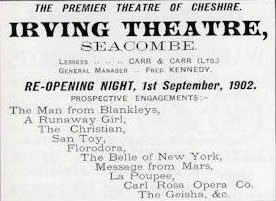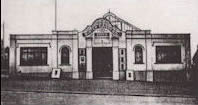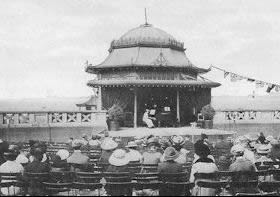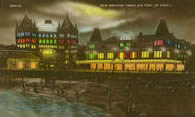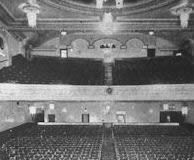From the 1890's to the outbreak of the Second World War, Wallasey was rich in 'live' entertainment, and local audiences were fortunate in being able to attend plays and concerts in which world-famous artistes appeared.
Apart from amateur productions, only the Floral Pavilion still carries on the tradition of 'live' entertainment in Wallasey. Some of the theatres became cinemas when the cinema ousted 'live' entertainment, which in turn cinemas closed in quick succession.
The Palace Theatre, on the Marine Parade, formed part of an ambitious scheme to give New Brighton a grand amusement centre. In 1881 it was announced that on Whit Monday the 'New Brighton Aquarium, Baths and Hotel Companies' splendid new Salt Water Baths would open, The manager was Mr J. Nolan. By 1882 entertainment were provided daily during the season, many of them being in the form of sacred concerts. On Good Friday, 1883, the following artistes appeared: Madame Rose Hersea, Miss Frances Armstrong, Mr Vernen Rigby and Mr Bantock Pierpoint. The Palace band and choir of seventy were conducted by Mr W.I Argent.
By 1885 the site consisted of the Grand Concert Hall, the Small Concert Hall, the "finest ballroom in England", Skating Rink, Aviary and Grotto. Entertainment of all types was given, from classical music to variety.
 |
In October 1887 Mr C.B Roylance Kent made, on behalf of Mr W.T Malood, an application for a theatrical licence for the Jubilee Concert Hall (a licence was necessary in those days before anything approaching a 'play' could be performed). He stressed that only the best of drama would be presented there; that Mr Malood, being the son of a Congregational minister, was a most was a most suitable person to run it; and that all precautions in case of fire, etc., had been taken, In spite of his eloquence the licence was refused.
The year 1982 saw the visit of the original 'Baldwin Cat' which, it was stated, climbed up a rope to the ceiling fifty feet high, attached itself, and made a parachute descent. About this time the title 'Palace and Pavilion Theatre' was first used.
Mr Charles Coburn, the celebrated comedian, made his first appearance at the Palace in 1894. The theatre was crowded for every performance and Mr Coburn made many return visits in subsequent years.
In 1895 the Palace was under the control of the 'New Brighton Palace Company'; the theatre was then extremely successful and only first-class artistes were engaged. The following year the building was purchased by a Manchester syndicate who planned to float a company with a capital of £140,000 in order to erect on the roof what was described as, 'the largest wheel in the world' alter the style of that at Earl's Court. The company was to be called 'The New Brighton Graydon Castle, Great Wheel and Towers Company', and the wheel was to contain forty-two carriages, each to accommodate forty passengers. A new theatre and salt water baths were also to be erected. Unfortunately this ambitious project never materialised.
By 1899 operettas, musicals and plays were all being performed at the theatre, some by London companies, and all by well-known performers.
There is little doubt that the opening of the Tower Theatre had a disastrous effects upon the Palace, although it managed to keep going. In 1903 it was the first hall in Wallasey to show animated pictures. The company responsible for this enterprise, 'New Century Pictures', controlled the Mount Pleasant Picture House, Liverpool.
Under the Wallasey Tramways and Improvement Act of 1907 the land and property were acquired by the Corporation for the sum of £41,500.
By 1908 animated pictures were firmly established at the Palace, although variety turns were still a feature, and this type of 'mixed' programme seemed to be quite popular.
The mixed entertainment continued throughout 1909-10, although the programme showed a slight preponderance of 'live' entertainment. Will Hay, described as an eccentric comedian, appeared in 1910, and included in the same bill was Sid Santo in his novel musical scene The Breakdown of the Nine-thirty Express. In October a full orchestra was introduced to aid the artistes, with Mr Arthur Lynn as musical director. Sandy Powell played at the theatre in 1911, achieving great popularity.
In 1913 (before the building of the Tivoli Theatre) the Tivoli Company Ltd. acquired control of the theatre and ran it in conjunction with the Victoria Gardens. The original idea was to rebuild the Palace, construct an arcade and erect a large hotel. However, owing to difficulties which had arisen over the building of the Tivoli, the plan had to be abandoned. The Corporation then asked for tenders for the tenancy of the theatre, and the highest (£520), that of Mr. Ludwig Blattner, was accepted. Mr Blattner renamed the building 'The Gaiety', and carried out many improvements and renovations. Under his administration the programme's contained more pictures than 'live' entertainment, and the Royal Bohemian Orchestra was engaged to play at every performance. A series of Sunday orchestral concerts was introduced, and Mr. A.Delmonte, the orchestra leader, became manager in 1914.
In April 1916, the greater part of the Palace site was destroyed by fire, but luckily, after desperate efforts by the firemen, the skating rink and the Gaiety Theatre were saved. The name of the theatre reverted to The Palace again in 1920. Later in the year it became known as 'The Palace Picture Playhouse', finally finishing as 'Collins' Palace Cinema'.
It was decided to close The Palace Theatre after its final performance on 11th December 1926. Soon afterwards the Palace was demolished and a car park occupied the site until August 1939 when Wilkes' Palace Amusements opened. The War office took over the building during World War II and used part for storage space with secret munitions factory operating under the building.
After the war the 'New Palace' was a success with holidaymaker's with new exciting rides such as the "Moonrocket". During the Summer months Wilmer Wilkes' Circus opened next to the New Palace. This was replaced by a permanent family funfair.
In the late 1980's Go-Karting was introduced to the Palace but closed in 2001 and in 2003, after redevelopment, 'Adventureland' opened which is an indoor children's play area that includes a 25 foot climbing wall, ball pool and giant inflatable's.
In Abel Heywood's description of New Brighton Promenade and Pier in his Guide to New Brighton and Birkenhead, 1892, we read, 'Running at the back of the center of the Pier is a covered saloon 130ft. in length and varying in width from 28ft. to 34ft. - it is available for bazaars, flower-shows, concerts, balls etc.'
In 1899 Adeler and Sutton's Pierrots, following the success of their shows on the shore, transferred to the Pier and created a 'sensation' there.
In 1900 the summer season lasted until 22nd December. Just prior to this date a special attraction was advertised: 'The Pier Pierrots Amalgamated Company of Star Artistes', who were to appear after a successful season at the Agricultural Hall, London. Also a special engagement was announced for twelve nights only of Malcolm Scott, who was to appear with Charles Harvey 'in the screamingly funny duets', A Weak Woman and The Lady and the Ship. Prices of admission were - Reserved seats 1s, unreserved 6d. which was inclusive of the Pier admission.
In 1902 the lessees were 'The Summer Entertainments Syndicate Ltd.', and the presentation for the summer season was once again Adeler and the Sutton's Pierrots. The programme consisted of comedy, songs and pianoforte playing. In 1903, 'that eccentric, excruciatingly funny artiste' Mr Malcolm Scott made his second appearance. Scott was a dame comedian of a female impersonator, and had been described by Lupino Lane, the silent movie comedian, as "one of the most brilliant performer of his time."
During the next few years Adeler and Sutton's Pierrots went from strength to strength, building up their reputation and creating a good impression wherever they went. In a guide issued in 1909 we read 'the Pavilion is under the management of Messrs Adeler and Sutton, who hold a unique position in the world of entertainment, in as much as they branches in nearly every seaside town and watering place in the country. The concerts given in the Pavilion are of a special type and are recognised as the nursery of the stars of the lighter side of the stage.'
In the 1908 season Berr Erroll appeared, giving what was described as, 'a remarkable female impersonation.' Another entertainer was Miss Mona Vivian, known as 'Wee Mona.'
In 1909 the interior of the Pavilion was completely reconstructed, redecorated and heated throughout. 'Pierograph' pictures were shown to supplement the stage shows, but this novelty was short-lived. The Russell Rosse Repertory Company paid a visit, including in their repertoire A Pair of Spectacles and A Fool's Paradise. In 1910 Pelissier's The Follies gave performances at the theatre.
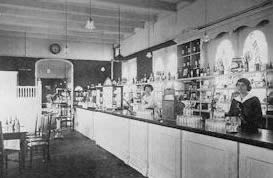 |
The first pantomime to be introduced at the Pier Pavilion was Dick Whittington, which ran for a week commencing 8th January 1912, and was immediately followed by Aladdin. In April of the same year The Scamps gave a performance, and among their cast was the famous actor and comedian Leslie Henson. In April 1913 it was announced that a new pavilion was to be built on the Pier at the promenade end, and that there would be a clear walk from the new pavilion to the sea front. The Pier Company was to provide the entertainment in future instead of leasing the building as in former days.
During the 1914 season many concert parties visited the Pier Pavilion including 'Ideals'. 'The Europeans'. 'Sequins', and the 'Poppies'. They were followed in 1915 by the 'Zeniths', 'Curios', 'Nobodies', and the 'Gaieties'. The opening show in 1916 was presented by Douglas Farber's London Company 'Glad Eyes', and 'The Mountebanks' opened the season in 1917. The Pavilion remained open during the whole of the war years . presenting the usual concert party or Pierrots troupe, with visits from well-known companies.
The Chrysanthemums Pantomime Society, then in its infancy, presented Cinderella in 1921, followed in 1922 by The Babes in the Wood and Robin Hood
The pier was closed in 1923 and four years later the Wallasey Corporation became its new owners and re-opened it with its own entrance from the promenade. The whole of the pier was rebuilt in 1931 at a cost of £45,000.
The closure of the New Brighton Ferry affected the life of the promenade pier. Fortes Limited became the owners in 1968, carrying out repairs and it continued for a time, but it was not a paying proposition. After much discussion, the pier was dismantled in 1978, the ferry pier having been demolished some five years earlier.
The Tower Theatre was opened on Whit Monday, 30th May 1898, by the New Brighton Tower and Recreation Company. There was seating accommodation for 2,000 persons, standing room for 500, and prices of admission ranged from sixpence in the amphitheatre to a guinea for boxes. The first performance consisted of variety, and included a band, wire-walking, songs, dancing, juggling, performing lions and a singing fox-terrier. In October 1899 the musical comedy, The General, by Captain Montressor, was enormously successful when presented under the direction of Mr W. Huish and was fallowed by a spectacular drama entitled, The Klondyke Nugget, by S. F Cody.
%20NB%20View%2025_06_1959.jpg) |
Variety returned in 1900, and in a special Easter programme Harry Lauder appeared, billed as 'the Popular Scotch Comedian.' This type of entertainment was most popular at the time, and in April 1902 'the Great and only Morny Cash' was advertised as the star turn. Morny Cash was one of the best-known variety artistes of his day, and it speaks well for the management of the theatre that such first-class performers were engaged.
During the year 1909 opera was introduced by the New Brighton Amateur Operatic Society, which presented the light opera, Marjorie in March. The season opened officially on Good Friday, April 9th , with Mr J. W Turner's Grand English Opera Company.
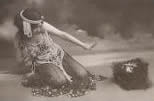 In August of the same year Maud Allan (1873-1956), the classical and sometime erotic dancer, appeared at the same theatre and was the centre of some controversy. The Tower was packed: during her performance many of the audience openly expressed disapproval and before her interpretation of Mendelssohn's 'Spring Song' Miss Allan had to appeal for silence. The year 1909 also saw the beginning of the famous Sunday Musical Concerts. Among the great artistes who contributed to their success were John McCormack, the three brothers Hambourg, Signor Tamini, Mesdames Ella Russell and Marguerite Stillwell. The concerts were greatly appreciated, and in 1910 Herr Fritz Kreisler. Perival Allen and Howard Jones appeared.
In August of the same year Maud Allan (1873-1956), the classical and sometime erotic dancer, appeared at the same theatre and was the centre of some controversy. The Tower was packed: during her performance many of the audience openly expressed disapproval and before her interpretation of Mendelssohn's 'Spring Song' Miss Allan had to appeal for silence. The year 1909 also saw the beginning of the famous Sunday Musical Concerts. Among the great artistes who contributed to their success were John McCormack, the three brothers Hambourg, Signor Tamini, Mesdames Ella Russell and Marguerite Stillwell. The concerts were greatly appreciated, and in 1910 Herr Fritz Kreisler. Perival Allen and Howard Jones appeared.
The Hebrew actor, John Lawson , arrived with his celebrated company in 1911 and took part in three sketches Humanity, The Monkey's Paw, and Sally in our Alley. Later in the year Mr E.T Hayes presented Miss Edith Goodall and members of Miss Horniman's Company in Candida. Many plays were given by full London companies, whose casts included such famous actresses as Joan Harcourt and Betty Fairfax.
On Sunday, 30th June, a Grand Choral and Orchestral Concert was presented by Madame Fanny de Boufflers, who incidentally, died at Wallasey in the eighty-first of her life, about 1950.
In 1912 two presentations direct from London were The Merry Widow and Miss Hook of Holland. All entertainment at the Tower was the best of its kind; the Hon. Norah Johnson, assisted by the London Symphony Orchestra and Sir Frederic Cowen, came straight from her great success at the Queen's Hall, and Madame Clara Butt also sang at this go-ahead provincial theatre. The announcement that Solomon, the marvelous boy pianist, was to play at the Tower, aroused keen interest.
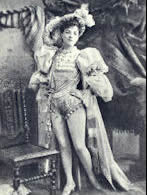 In September, 1917, the great music hall artiste Vesta Tilley arrived, and included in her repertoire her latest London triumph, Six Days Leave. Lady Constance Stuart Richardson, the famous dancer from the Palace and Lambeth Theatres, also graced the stage. Madame Clara Butt returned to the theatre on Good Friday, 1918, and other famous names on the programme were madame Elso Stralia, Miss Mary Hill, and Lady Tree. In 1925 Gracie Fields appeared in the revue by Archie Pitt, By Request. Two other revues by this writer were produced about the same time, A Week's Pleasure starring Betty Fields, and Too Many Cooks, in which Douglas Wakefield took the lead.
In September, 1917, the great music hall artiste Vesta Tilley arrived, and included in her repertoire her latest London triumph, Six Days Leave. Lady Constance Stuart Richardson, the famous dancer from the Palace and Lambeth Theatres, also graced the stage. Madame Clara Butt returned to the theatre on Good Friday, 1918, and other famous names on the programme were madame Elso Stralia, Miss Mary Hill, and Lady Tree. In 1925 Gracie Fields appeared in the revue by Archie Pitt, By Request. Two other revues by this writer were produced about the same time, A Week's Pleasure starring Betty Fields, and Too Many Cooks, in which Douglas Wakefield took the lead.
From the late 1930's the Tower Theatre appears to have been used only for pictures and spectacular presentations. Wrestling became a weekly feature in 1937, and proved popular with a certain section of the community. Sunday concerts were revived in 1944, but unlike the old ones, took the form of dance bands and variety turns, During the war the building was used as a Garrison Theatre by the Americans whenever one of their own road shows was in the vicinity.
A special Victory Concert was arranged at the Tower Theatre after the Second World War. The choir was conducted by Stainton de B. Taylor. The theatre was decorated with all the flags of the Allies and presentation was made to Lt. Cdr Ian Fraser, the town's Victoria Cross holder.
With the deterioration of the Tower Grounds, due in large to the fall in numbers of visitors to New Brighton, the building fell into dis-use and slowly began to be a bit of an eyesore. The end of the Tower came when it was destroyed by fire on 5th April 1969, the fire brigade fought the flames for hours and all that was left was the shell, this was dismantled and the site was cleared. Eventually, it was grassed over and a house building company purchased the old athletic ground and stadium from the local council and build a whole new housing estate, which is called River View Park. The remainder of the ground is used by the community and has a swing park and football pitch.
The Theatre in Borough Road, Seacombe, stands on a site once occupied by Hope House and its gardens. It was opened on 18th December 1899 by Sir Henry Irving, who allowed his name to be associated with the building on the strict understanding that the best of legitimate drama would be produced there. Mr J. Kierman, in applying for a licence, declared that accommodation had been provided for 2,500 persons and that fourteen dressing rooms were available.
The theatre opened with The Sign of the Cross and other plays were A Royal Divorce, The Little Minister, The Only Way, and Charley's Aunt. In 1901 Uncle Tom's Cabin, in which Harry Bedford portrayed 'Uncle Tom', was described as one of the best presentations local people had had the opportunity of seeing for a long time.
In October, 1902, Mr J.H French became manager, and under his administration musical comedy and pantomime were introduced; Floradora was performed twice in one year, and a company of juvenile artistes presented The Sleeping Beauty in February 1907. Among the cast was Wee Georgie Wood, then a talented boy of eleven and a fine mimic of well-known music hall celebrities. In the show was another young man, thought by his contemporaries to be rather too old for the show (as he was then in his teens) and decidedly 'untalented'. After a conference it decided to give this boy the part of a golliwog; in fact it was considered by some that he was given a part at all only because his father owned three of the four theatres and the producer did not want to offend him. So young Stanley Jefferson was 'suited'. The name, which meant nothing to anyone then and means nothing to people now, was later changed to Stan Laurel of the Laurel and Hardy partnership.
During the summer months the theatre showed silent pictures, reverting to theatre again in September 1908; in the ensuing months the following plays and musicals were presented: School For Scandal, The Walls Of Jericho, The Merry Widow, and The Still Alarm. The last play, which incorporated a special engine-house scene, had live horses harnessed to a real fire-engine on the stage. Ironically, a week later, on the 19th December 1908 fore caused £1,000 worth of damage which necessitated closing the building for nine months for repairs and renovations.
On the 13th September 1909, the theatre opened as 'The King's', with Mr Robert MacDonald's play of the year The Dairymaids. During 1910 variety became part of the repertoire and was very popular. Nevertheless, plays. musical comedy and pantomime still held their place with a large section of the audience, and programmes were of a very varied nature.
On Easter Monday, 1912, Mr Ludwig Blattner took over the management and the theatre was renamed 'La Scala'. A new feature was the introduction of the Cosmopolitan Orchestra, under the direction of Blattner himself. Pictures were then so much to the fore that the building was advertised as 'The Philharmonic Cinema', and the only artiste of note who appeared at the theatre in person was Charles Coburn, 'The Man who broke the Bank of Monte Carlo'. 'La Scala' seemed to be losing some of its attraction, and a new general manager, Mr John Gaffney, was appointed. Under his guidance the theatre appeared to gain a new lease of life. Variety, revue, and occasionally a straight play provided the main forum of entertainment. In 1917, the play Casta was presented, with Albert Chevalier playing the chief character 'Eccles'. The company was declared to be one of the best to ever visit Wallasey and caused a box office boom. In May, 1918, the 'one and only' Dr Walford Bodie came to the theatre, and the same year the Wallasey Police Minstrels, for one night only, gave the last show to be presented at 'La Scala'.
On Monday, 12th August 1918, the grand opening of the Wallasey Hippodrome was announced, after the building had been 'substantially improved and handsomely equipped.' Mr A.J Morgan of the Salon Company Orchestra, and the name was changed once again - this time to the 'Casino'. Variety continued to be the only form of entertainment offered to patrons, but the new regime did not last very long. On Monday, 3rd September, the theatre opened its doors again as the Hippodrome. Among the items included on the programme this time we find Mr F. Rowland-Tims, F.R.C.O, playing the largest movable stage organ in existence, in a scena A Musical Romance. Miss Hettie King, described as the world's greatest male impersonator, visited the Hippodrome in 1924, followed by a return visit of Dr Walford Bodie, 'the Radio King'.
During the first half of 1926 the theatre returned completely to legitimate drama; the change of policy was very popular, at least for a short time, as in August the Hippodrome became known as the 'Irving Repertory Theatre', under the management of Mr A.L Bayley. The new repertory era lasted only until December; some of the plays presented were The Temptress of Paris, A Bill of Divorcement and The Price of Coal.
When the repertory season finished the theatre became known as the 'Irving' again, even though it was used for variety shows. In 1928 the Gordon Circuit acquired the theatre, spent £1,500 on improvements, and opened it under the managership of Mr Claud King on Easter Monday, 1928, as the Hippodrome. In 1929 Wilkie Bard appeared in two of his famous sketches The Cleaner and The Night Watchmen. The Hippodrome was again closed for a time, until opened by Mr F.V Ross, in March 1930. Shortly afterwards it closed down again, this time until 1934, when it reopened with Mr Pat Collins, as proprietor, and 'Dick Batch' as manager. Sid Dooley's revue I'll Be Seeing You was the opening attraction, Wal Langtry, himself in the cast, presented his own road show Fun Mixture later in the month. During the week commencing 24th December 1934 the revue West End Scandles commenced its provincial tour at the Hippodrome having come straight from the Garrick Theatre, London. The chief comedian was none other than Tommy Trinder. Billy Merson, who song 'The Spaniard That Blighted My Life' made him world famous, was top of the bill in a week's variety show in April 1935.
However, notwithstanding the high standard of entertainment, the days of the Seacombe theatre were numbered. Live entertainment was being supplanted by moving pictures everywhere: on 2oth April 1936, the building was taken over by the Buxton Theatre Unit, to be operated as a cinema, and was renamed the 'Embassy'; subsequently it became one of the North-Western Group of Cinemas. Twenty-three years, owing to a lack of public support, it was closed on 21st March 1959.
Albert Douglas, a member of the well-known theatrical family, came to Merseyside on business in 1907, and realising how little entertainment there was in Wallasey, decided to stop. With Mr H.E Jones as a partner, he leased the Conservative Hall in Atherton Street and renamed it Alexandra Hall. Shows were presented every Saturday evening beginning with the Horbury Hand Bell Ringers as the chief attraction on 19th October 1907, the takings were 51s.9d. After a few weeks it was decided to open nightly, but the financial return was even worse.
In February 1908 the name was changed to the Winter Gardens, and palms were placed round the auditorium to justify the appellation. An orchestra was introduced, and programmes included variety, silent films and plays; but loses were still considerable until the John Riddling Opera Company came for a week. The theatre was packed for all performances, and from then onwards business increased. Among the stars to visit the Winter Gardens were Laurence Irving, who appeared in a one-act play, and Edward Terry who played in Sweet Lavender, Liberty Hall and other presentations.
In 1909 a limited company was formed to purchase the building, and alterations on a major scale were commenced in March of that year. A 'Circle' was provided, and an entirely new stage measuring sixty feet by thirty-three feet was installed, with adequate new 'flies' and a modern electric lighting system. After closing only four weeks and three days, the theatre was reopened; the work had proceeded day and night, and the last sections of the stage floor, and slating of the stage roof, were completed just 10 minutes before the doors opened. The attraction was a variety show. The following Monday, Moody Manners' Opera Company began a two-week's season with Zelie de Lussan starring in Carmen and Samson and Delilah. Plays and musicals predominated afterwards, and two artistes who frequently appeared were Ethelbert Edwards (afterward Henry Edwards of film fame) and J. Hamilton Stewart. In 1911 Owen Nares made his first appearance, being paid five pounds per week to take the lead in Old Heidelberg, which later formed the basis of The Student Prince.
During the Great War the theatre remained open and in spite of many difficulties made a modest profit. In 1919 Albert Douglas became sole manager director, with his eldest son A.C Douglas as general manager. It was not unusual for London success to visit New Brighton before going on to Liverpool, and from 1919 onwards many famous stars appeared including the following: Sybil Thorndyke, Edmund Given, Leon M. Lion, Bobby Howes, Fred Terry, Julia Neilson, Martin Harvey and Matheson Lang. Musical productions included: D'Oyly Carte Opera Company, Carl Rosa Opera Company, No, No, Nanette, White Horse Inn, Street Singer and Maid of the Mountains.
In 1924 the younger side of the management wanted to rebuild the theatre on modern lines, but this was vetoed by the older side. However, in 1929 all the directors agreed on rebuilding and work was commenced in February 1931. The Winter Gardens was reopened the following June and for three months was exceedingly successful; then came the world financial crisis and the theatre, in common with all other places of amusement, suffered badly. During a week in March takings fell to forty-seven pounds. Shortly afterwards there was one week of closure, but Albert Douglas decided to reopen and reimburse the Limited Company, if necessary, for any losses. His efforts were successful, and once again business reached a steady and profitable level. One of the most popular features was the annual summer visit of the Liverpool Playhouse Company. Audiences had the pleasure of seeing such well-known and popular artistes as James Harcourt, Wyndham Goldie, Ena Burrill, Marjorie Fielding, Ronald Squire, and Arthur Chesney.
Emilyn Williams paid two visits to the Winter Gardens, the first time appearing in Night Must Fall. Every night audiences included coach loads of people from North Wales where the play had been widely advertised. His second appearance in Wallasey in The Corn is Green produced the largest takings in the history of the theatre, over £2,000 gross.
Vincent Douglas, youngest son of Albert Douglas, wrote his first play The Jeffersons. when he was eighteen years of age. The original production was in New Brighton and afterwards it toured for many years with great success. His other plays included, The Partners, The Optimist, Perfect Wife, and Christmas Dream. The death of this promising young playwright on his twenty-sixth birthday was a tragedy.
In 1936 the theatre was sold to the Cheshire Picture Halls Ltd, but Douglas remained managing director for twelve months and advisory director for a further twelve months.
With the outbreak of war in 1939 the Winter Gardens had to close down, and the performance on the night before the declaration of war was the last with which Douglas was associated with the theatre. Douglas died soon afterwards on the 19th February 1940. He had bought to the town entertainment seldom seen outside London, He knew many great actors of the day and was sadly missed. He was aged 78 and had been a life-long teetotaler and was also a non-smoker. In 1942 the Winter Gardens reopened with the BBC broadcast Florence de Jong playing the organ. 'Guest Nights' for amateur talent became a popular feature of the cinema.
After the war the Winter Gardens passed over to the S.M Associated Cinema, and in 1954 to the Essolco Circuit. Although at this time it was used mostly as a cinema, programmes were still varied and repertory drama was produced by the Nita Valarie Winter Garden Repertory Players in 1954 and again for short season in 1956. In the latter year the 'Essoldo Follies' also appeared in revue and the theatre for a little while was peopled by 'live' performers.
The theatre was put up for sale and had a reserve of £15,000. Television had arrived and, like everywhere else, it had an effect on the town's dozen cinemas. The building remained closed, then reopened as a bingo hall for a period.
The building was later demolished and sheltered housing now occupies the spot.
The New Victoria Gardens, which were opened on the 3rd May 1913 by the Rt. Hon The Earl of Derby, replaced the ill-famed 'Ham and Egg Parade' and included an open air Hemicycle Pavilion and Bandstand.
For the first year of its life the Pavilion was run by the Mersey Entertainers Ltd, and the programmes consisted of variety. Concert parties as well as individuals were engaged by the season, and among the first artistes to appear were Jack Hilton, Dorothy Walsh, Douglas Stewart and Howard Innes.
In 1914 Teel's Pom Poms provided the entertainment, but owing to war the theatre was very little used for the next few years. In 1917 a concert party called 'The Onchans' arrived from the Isle of Man, and were so successful that they were engaged for the next two seasons. At the beginning of 1920 Victoria Gardens came under the control of Pat Collins, jnr. Numerous concert parties paid brief visits to the Pavilion including 'The Topics'. 'The Big Seven', 'The Daintes', 'The Onchans', were again the chief attraction in 1921 and 1922. Mr Charles Harvey, described as, 'The King of Pierrots Comedians', appeared and presented his own concert party in The Victorians the following year, and in 1924 Mr A. Douglas leased the theatre for three months, bringing to New Brighton a number of famous shows and stage personalities. Later in the season the Co-optimists 'A' company, To-morrow and Pan all played there. The British Guiana Military Band, direct from the Wembley Exhibition, gave a three-day performance, and Lydia Kyasht, the world-famous Russian dancer, made a personal appearance on two occasions.
For the summer season of 1925 the Pavilion was transformed into one of the finest concert halls in the kingdom. It was completely re-floored and redecorated; the stage was raised and seating provided for 1,200 persons. The new leases were Messrs Frank Terry and Os. Battye, and the building became one of New Brighton's greatest attractions. 'The Super Optimists' opened the season, with Jessie Crone, Darry Delmore, Hilda Ellis and Jenny Dean. Catlin's Royal Pierrots opened the 1926 season, and with this company was Fred Yule of 'ITMA' fame, described as a baritone with a fine, powerful voice. The year 1928 also saw the institution of Sunday concerts, for which Delmonte's celebrated orchestra was engaged. In 1930 the 'Super-Optimists' returned, and were the winners of the Sunday Dispatch prize for, The most popular concert party in the British Isles', with 10,000 votes. The cast included Hilda King, Eddie Elen, Charles Renton, Carol Warwick, Cecil Reed and Phil Strickland, as well as two old favourites Jessie Crone and Frank Terry. On the Grand Farewell night the party was 'snowed under' with requests, and one newspaper reported that, 'Never in the history of the Victoria Gardens have there been such remarkable scenes of enthusiasm.' Mr Frank Terry informed the audience that negotiations were already proceeding with Wallasey Corporation for the tenancy of the Pavilion and that he believed he would be back in the Pavilion next year. He did indeed bring back the 'Super-Optimists' back in 1931, in a summer-time revue called Pleasure on Parade and before the season was out the company had broadcast more often than any other concert party in the British Isles.
The 1932 edition of the 'Super-Optimists' opened the season on Saturday, 14th May, with most of the previous year's artistes. Frank Terry also opened the theatre for two days at Christmas, to present a novelty show entitled Xmas Pleasure.
Because of the great success of previous broadcasts, the BBC honoured Frank Terry with the first summer programme in 1933. Mr Terry had been touring the 'Lancashire Mummers' during the winter of 1933-34, and in order to allow them to open the new season at the New Pavilion, Colwyn Bay, the season at the Floral Pavilion was opened by Murray Ashford's Hello Happiness. The Pleasure on Parade company arrived later in the year.
In June 1935 Frank Terry presented his Jubilee Pleasure Parade with George Betton, a 'local lad' as chief comedian.
In 1936 company of Pleasure on Parade had an almost entirely new cast, except for Claude Branston and Jack Strand both of whom had appeared many times before: among the newcomers was Nita Valerie, a clever soubrette and dancer.
 Before the end of 1937 the number of broadcasts had risen to seventy-six and in 1938 Mr Terry decided to change the name of the show to New Brighton Follies. The Party continued under this title until the outbreak of war in 1939. Led by Phil Strickland, the 1940 edition of Pleasure on Parade made its appearance despite wartime difficulties - even in those dark days the Floral Pavilion was still broadcasting. There were a number of shows in the period 1941-44, and during that time Robb Wilton, Wilfred Pickles, Bunny Boyle, Tommy Handley, Cavan O'Connor, Dick Henderson and Dorothy Summers ("Can I do you now, sir?") all appeared there. Melody Inn was first booked at the Floral Pavilion, in 1948 and ran for a record-breaking 25 years.
Before the end of 1937 the number of broadcasts had risen to seventy-six and in 1938 Mr Terry decided to change the name of the show to New Brighton Follies. The Party continued under this title until the outbreak of war in 1939. Led by Phil Strickland, the 1940 edition of Pleasure on Parade made its appearance despite wartime difficulties - even in those dark days the Floral Pavilion was still broadcasting. There were a number of shows in the period 1941-44, and during that time Robb Wilton, Wilfred Pickles, Bunny Boyle, Tommy Handley, Cavan O'Connor, Dick Henderson and Dorothy Summers ("Can I do you now, sir?") all appeared there. Melody Inn was first booked at the Floral Pavilion, in 1948 and ran for a record-breaking 25 years.
The glass structure of the Pavilion was replaced at the cost of £55,000, re-opening in May 1965 as The Floral Pavilion Theatre. Since then they have staged many one-night shows with such artistes as the late Sir Harry Seacombe, Val Doonican and many more. Many local amateur local productions were shown at the theatre and in the early 1990s further renovating work was carried out.
As part of redevelopment on the New Brighton promenade the Floral Pavilion was demolished in 2006 and a new £12 million 800 plus seat Floral Pavilion and Conference Centre was built. The new complex opened on 13th December 2008 featuring Ken Dodd and his Happiness Tour. Other shows for 2009 range from West Kirby Light Opera Society Chess, Bill Kenwrights arrangement of Agatha Christie's Spiders Web, St Paul's Operatic Society My Fair Lady and for Christmas Snow White and the Seven Dwarfs pantomime.
The Tivoli
The Tivoli was opened by the New Brighton Tivoli Company Ltd, the week before Easter 1914, with Lily Langtry as the chief attraction. After only eight weeks the theatre was sold to The Tivoli Leases Ltd and under this organisation was run very successfully until 1923, For the next two years the owner was the well-known showman Pat Collins, and then in 1925 the Tivoli was sold by auction to Mr William Swire, who one year later sold it to the former owners, The Tivoli Lessees Ltd, and in 1928 the Gaumont British Company purchased it. The Tivoli set up a record by having four hundred consecutive Sunday concerts at which many of the great stars of music and song appeared. From 1914 to 1923 it was the biggest Vaudeville gold mine on Merseyside, and an idea of the money made can be gauged by the fact the King's Theatre, Seacombe, was bought from £8,000 out of the profits.
Under the ownership of the Gaumont British Company the theatre was run for a short time as a cinema and variety house and afterwards was leased for short periods to various people. For a few months during 1937 the theatre became known as the New Tivoli, but this title was soon dropped. The Tivoli remained closed from 1938-40, when it was once again reopened by The Tivoli Leasees Ltd but had to close down after four months due to damage caused by enemy action.
The name of Mr F.V Ross is prominent in the history of the theatre during the 1914-40 period. He was responsible for arranging the very successful Tommy Handley Memorial Concert held at the Floral Pavilion.
It was not until 1945 that the theatre was reopened by the new lessees, Leam Productions Ltd, whose policy was to present twice-nightly variety during the summer season, and to engage a repertory company for the winter months. The first company to appear was Frank Fortescue's Repertory Players. They were followed by Harry Hanson's Court Players, who played for two seasons, and were succeeded by Richard Stephenson's Saxon Players. The repertory season, though apparently not too popular at first, gained many supporters as audiences acquired the 'repertory habit'.
Due undoubtedly to the impact of television, the Tivoli, in common with many other provincial theatres and music halls, suffered from failing attendances, and efforts to save it from closing were to no avail and it closed on April 1955.
Later the theatre was transformed into an amusement arcade but by the 1970s it was boarded up. In 1976 the building was demolished after it had suffered a fire. Apartments now occupy the site.
Featured sites
- Non Gamstop Casinos
- Casino Not On Gamstop
- UK Casinos Not On Gamstop
- Non Gamstop Casinos UK
- Sites Not On Gamstop
- Sites Not On Gamstop
- Casinos Not On Gamstop
- Casinos Not On Gamstop
- Casinos Not On Gamstop
- Non Gamstop Casino UK
- Casinos Not On Gamstop
- Non Gamstop Casino
- UK Online Casinos Not On Gamstop
- UK Online Casinos Not On Gamstop
- Non Gamstop Casinos
- Casino Sites Not On Gamstop
- Casinos Not On Gamstop
- Casinos Not On Gamstop
- Best Betting Sites
- Casinos Not On Gamstop
- Gambling Sites Not On Gamstop
- Betting Sites That Are Not On Gamstop
- Non Gamstop Casinos UK
- UK Online Casinos Not On Gamstop
